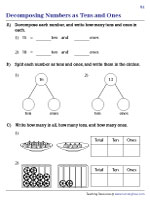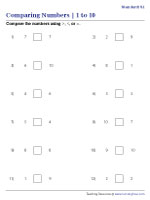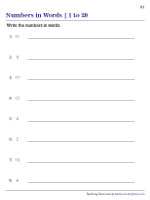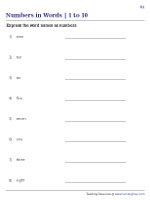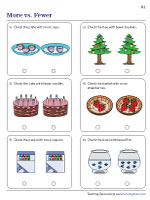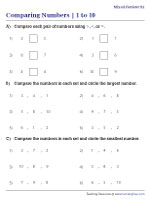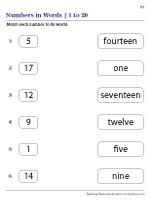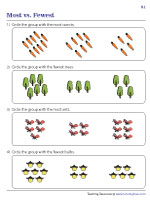Kindergarten Math Worksheets
Discover our kindergarten math worksheets packed with exercises for kids on number recognition, place value, counting, adding, subtracting, patterns, shapes, money, comparing sizes, understanding more than/less than, identifying relative positions, decomposing numbers into tens and ones, recognizing and sorting coins, backed by word problems. The easy-to-use answer keys make evaluation effortless. Build a strong foundation with our free worksheets.
Select Kindergarten Math Worksheets by Topic
Explore Kindergarten Place Value Worksheets
Counting and Comparing Numbers up to 10
Are the number of keys more than, less than, or equal to the number of locks? Count the objects on each side and compare the quantity using >, <, or = symbols.

Matching Number Words and Numerals
Read the numbers and pair them with the corresponding number words. Draw lines connecting 1 and one, 3 and three, and so on!

Decomposing Numbers into Tens and Ones
Break down each number as tens and ones in parts A and B. In Part C, count the total number of items and record how many tens and ones there are.

Unscrambling Number Words from 1 to 10
Unscramble the word name of each number from the jumble of letters and write it in the space given.

Comparing Numbers up to 10 | Type 1
Is 2 greater or lesser than 5? Compare numbers on either side and place an appropriate symbol between them.

Writing Numbers in Words | Up to 20
Read each number and write its name in the space provided. Make sure to spell out each number name accurately.

Expressing Word Names as Numerals within 10
Write the numeral "10" if you read the number name "ten". Similarly, write "6" if you read the number name "six". Replace each number name with its numeral representation.

Identifying Groups with More or Fewer Objects
Count the objects in each set and determine which set has more or fewer items. Indicate your findings by checking the appropriate set.

Comparing Numbers up to 10 | Type 2
Using the symbols >, <, or =, compare the numbers. Find and circle the biggest number in the set. Finally, hunt and highlight the smallest number.

Matching Numerals with Number Words
Pair 11 with eleven, connect 8 with eight, and match the other number words to their names.

Determine how many counters are on each ten-frame and use symbols to indicate whether one ten-frame has more than, fewer than, or the same number of counters as another ten-frame.

Identify the numbers from 1 to 10, spell their names correctly, and write them in the spaces provided.

Count the number of objects in each set, then draw an arrow to indicate which picture has "more" objects and which one has "fewer" objects.

Converting between Numerals and Their Word Forms
Get on a conversion spree and change the numerals into number words and number words into numerals.

Count how many objects are in each set and determine which set has the most or the fewest items. Circle the set with the maximum or minimum number of items as directed.


 Interactive Worksheets
Interactive Worksheets Worksheets by Grade
Worksheets by Grade Number Sense and Operations
Number Sense and Operations Measurement
Measurement Statistics and Data
Statistics and Data Geometry
Geometry Pre-Algebra
Pre-Algebra Algebra
Algebra


